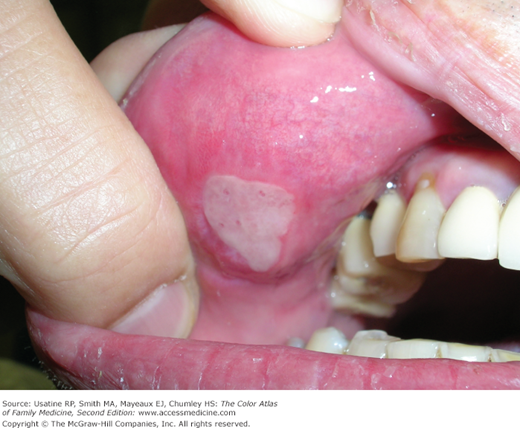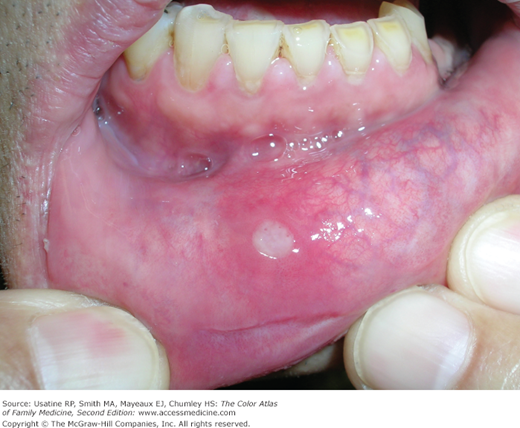Patient Story
A 58-year-old man presents with a 1-year history of painful sores in his mouth. (Figures 41-1, 41-2, 41-3, and 41-4). He has lost 20 pounds over the past year because it hurts to eat. The ulcers come and go, but are found on his tongue, gums, buccal mucosa, and inner lips. Prior to the onset of these lesions the patient had been in good health and was not on any medications. The physician recognized his condition as recurrent aphthous ulcers with giant ulcers. No underlying systemic diseases were found on work-up. The patient was started on oral prednisone and given dexamethasone oral elixir to swish and swallow. Within 1 week the patient was able to eat and drink liquids comfortably and began regaining his lost weight. Long-term management of his problem required the use of other medications so as to successfully taper him off prednisone without recurrences.
Introduction
Aphthous ulcers are painful ulcerations in the mouth which can be single, multiple, occasional, or recurrent. These ulcers can be small or large but are uniformly painful and may interfere with eating, speaking, and swallowing. Oral trauma, stress, and systemic diseases can contribute to the occurrence of these ulcers but no precise etiology is apparent. Recurrent aphthous stomatitis (RAS) is a frustrating condition that merits aggressive treatment aimed at pain relief and prevention.
Epidemiology
Etiology and Pathophysiology
- The precise etiology and pathogenesis of this condition remains unknown, although a variety of host and environmental factors have been implicated.
- A positive family history is seen in about one-third of RAS patients. A genetic predisposition is suggested by an increased frequency of HLA types A2, A11, B12, and DR2.1
- In one study, Th1 (T-helper subtype 1) activation was more intense in the patients with RAUs. Many conditions that increase the incidence of RAUs, such as psychologic stress, NSAIDs, Crohn disease, and celiac disease, also shift the immune response toward the Th1 subtype. Conditions and medications that inhibit the Th1 immune response pathway, such as pregnancy, thalidomide, glucocorticoids, and tetracycline, decrease the incidence of RAUs.2
- Another study found significantly higher-than-normal serum level of tumor necrosis factor (TNF)-α in 20% to 39% of patients in the ulcerative stage of RAUs.3 Medications that have anti-TNF-α effects, such as pentoxifylline, levamisole, and thalidomide, have also been found to be useful in the treatment of RAUs.1–3
- Although studies show that there are active immune mechanisms associated with RAUs, there is still much to learn regarding their etiology and pathogenesis.
Risk Factors
Diagnosis
History:
- Symptoms may begin with a burning sensation and the pain is exacerbated by moving the area affected by the ulcer.
- Eating often hurts, especially foods and drinks with a high acid content.
- Ask about recurrences and onset in relation to the use of medications.
- Ask about GI symptoms, genital ulcers, HIV risk factors, and joint pain.
Physical:
- Three clinical variations are described based on the size of the ulcers: Minor (4 to 9 mm), major (>1 cm), and herpetiform (<3 mm). The most common minor form appears as rounded, well-demarcated, single or multiple ulcers less than 1 cm in diameter that usually heal in 10 to 14 days without scarring (Figure 41-5).
- The ulcers are solitary or multiple covered by a white-to-yellow pseudomembrane and surrounded by an erythematous halo (Figure 41-5).
Stay updated, free articles. Join our Telegram channel

Full access? Get Clinical Tree






